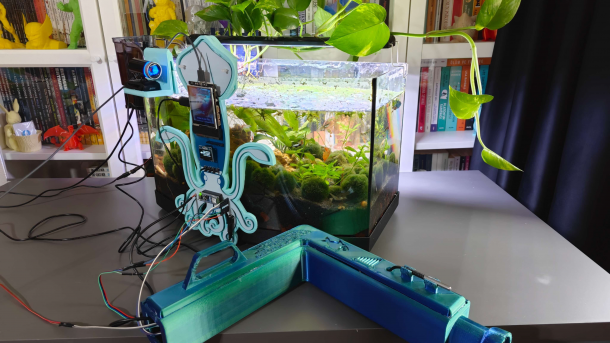AI-supported water analysis
With the help of self-trained AI and Maker technology, declining water quality can be detected before it becomes dangerous for aquarium inhabitants.

(Bild: Kutluhan Aktar / Hackaday)
- Daniel Schwabe
Using the waterproof ultrasonic sensor URM15 and an Arduino Nano ESP32, maker Kutluhan Aktar has developed an AI-based early warning system for declining water quality in aquariums. Assuming that declining water quality at an early stage (not yet harmful to the small ecosystem) leads to gas inclusions in the aquarium substrate, the bottom is scanned with the ultrasonic sensor.
In combination with an acceleration sensor, a 20 × 20 data point field is scanned first. The data from the ultrasonic sensor is then analyzed on the ESP using an AI model. This AI model was trained on the Edge Impulse platform and exported to the ESP. The analysis of the data then indicates whether bubbles were found or not. The collected data is then pushed to a web server. The ESP can be operated using four buttons and an SSD1306 OLED display.
Additional visual inspection
In addition to this substrate analysis, the project also includes a visual analysis via water tests. An Unihiker board – an SBC with a quad-core ARM Cortex A35 processor and touchscreen – is connected to a webcam. This webcam takes photos of water tests, which are analyzed and classified using Nvidia's RetinaNet. Depending on the test result, the analysis then shows whether everything is OK or the system reports contaminated water.
Empfohlener redaktioneller Inhalt
Mit Ihrer Zustimmmung wird hier ein externes YouTube-Video (Google Ireland Limited) geladen.
Ich bin damit einverstanden, dass mir externe Inhalte angezeigt werden. Damit können personenbezogene Daten an Drittplattformen (Google Ireland Limited) übermittelt werden. Mehr dazu in unserer Datenschutzerklärung.
The Unihiker also converts the ultrasound results of the ESP32 into a human-readable form. All the collected data, the images and the analysis results are then sent to the user via the messenger service Telegram. The Unihiker part of the project is controlled directly via its touchscreen.
Maintaining the aquatic theme, Kutluhan Aktar has also added a self-designed circuit board to the project and installed it in a squid-shaped 3D-printed housing. All information about the project and its significance for fish farming can be found on the Hackaday project page.
If you like nature a little drier, but still want to use high-tech, you can find everything about LoRa gateways in the wild in our article about the Birkenfelder Box.
(das)